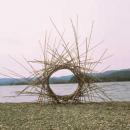Lab:
The Lab is a source of information for Artists and Art Lovers alike. You can find useful information to help develop your career as an artist such as tutorials, interviews, news, and a lot more!

Make it Site-Specific.
Year after year we see more and more site-specific art projects, both in urban and natural environments. These initiatives not only decorate and improve the appearance of public spaces, or commemorate a special event; they also bring contemporary art closer to the public and encourage cultural programmes to make them accessible to society as a whole.
Awareness around intervention, protection and bringing public spaces and society together is growing. The decentralisation of the exhibition space is expanding as more and more exhibitions are taking place outside museum and gallery grounds. It’s all about moving away from traditional exhibition spaces, offering new alternatives, and giving artists the opportunity to work in different environments.
In order to produce a good public art project, artists should ask themselves the following questions:
- Who are the people involved in a public art project?
- Which criteria should be followed?
- What is the purpose of a public art project in an urban or natural environment?
- How should an art project in a public space be managed?
- Should I ask for advice and the opinion of public art experts?
- Which criteria should I follow in order to correctly integrate my artwork in a public space?
- Which materials should I use in a public space project?
- Where should the artwork be situated in a public space?
- Should I ask for public opinion?
- What are the reasons behind vandalism?
- How can I manage the conservation and restoration of my artwork?
Here at The Art Boulevard, we recommend that when conceptualising your artistic project, the cultural, geographical, political and social context must be taken into account, thus making it a site-specific project. Visual artists, as well as set designers, musicians, poets, dancers or performers, can find inspiration in the environment where their art will be shown, creating a symbiosis between the artwork and the site.
Thanks to site-specific projects, we learn about our environment and start looking at it from another point of view, making something ephemeral and fragile, a quality, and an element of protection. Lots of artists respect and use natural resources and the environment to create site-specific projects, Andy Goldsworthy is one of them.
Andy Goldsworthy’s work is an adaptation of his projects to the environment using natural material from the site where the work will be shown. The artist uses the environment as a stage, and produces artwork made of ice, leaves, or stones, bringing to life the material extracted from the earth. He creates shapes, compositions, and sculptures that totally integrate themselves into the landscape and, as with any organic element, have their own lifecycle, which ends by merging fully with its surroundings.
Andy Goldworthy doesn’t introduce any element that is strange or foreign to the site. The shapes he creates flee from the ostentatious and offer us works of art that are nothing more than recycled nature.
It could be said that Goldsworthy truly represents this concept, however there are many other artists who work on site-specific projects, for example: Robert Smithson, Richard Serra, Susana Solano, Fernando Sanchez Castillo, or Francis Alys. We encourage you to go and see their work, study them and see how strongly their work is linked to their surroundings.
And last but not least: be site-specific.


